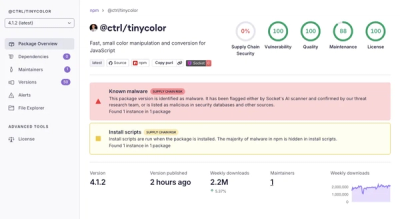react-style-tag
Write styles declaratively in React
Table of contents
Installation
$ npm i react-style-tag --save
Usage
import Style from 'react-style-tag';
const Style = require('react-style-tag').default;
Implementation
import React, {
Component
} from 'react';
import Style from 'react-style-tag';
class App extends Component {
render() [
return (
<div>
<h1 className="foo">
Bar
</h1>
<Style>{`
.foo {
color: red;
}
`}</Style>
</div>
);
}
}
Summary
react-style-tag creates a React component that will inject a <style> tag into the document's head with the styles that you pass as the text content of the tag. Notice above that the styles are wrapped in {` and `}, which create a template literal string. Internally, react-style-tag parses this text and applies all necessary prefixes via autoprefixer. All valid CSS is able to be used (@media, @font-face, you name it).
The style tag that is injected into the head will be automatically mounted whenever the component it is rendered in is mounted, and will be automatically unmounted whenever the component it is rendered in is unmounted.
Scoped styles
There is an additional utility provided that can help to scope your styles in the vein of CSS Modules, and this is hashKeys. This function accepts an array of keys to hash, and returns a map of the keys to their hashed values.
import Style, {
hashKeys
} from 'react-style-tag';
const classNamesToHash = ['foo', 'bar'];
const {
foo,
bar
} = hashKeys(classNamesToHash);
class App extends Component {
render() {
return (
<div>
<div className={foo}>
My text is red due to the scoped style of foo.
</div>
<div className={bar}>
My text is green due to the scoped style of bar.
</div>
<div className="baz">
My text is blue due to the global style of baz.
</div>
<Style>{`
.${foo} {
color: red;
}
.${bar} {
color: green;
}
.baz {
color: blue;
}
`}</Style>
</div>
);
}
}
Notice you can easily mix both scoped and global styles, and for mental mapping the scoped styles all follow the format scoped__{key}__{hash}, for example scoped__test__3769397038. The hashes are uniquely based on each execution of hashKeys, so the implementation can either be Component-specific (if defined outside the class) or instance-specific (if defined inside the class, on componentDidMount for example).
Props
Naturally you can pass all standard attributes (id, name, etc.) and they will be passed to the <style> tag, but there are a couple of additional props that are specific to the component.
doNotPrefix boolean, defaults to false
If set to true, it will prevent autoprefixer from processing the CSS and just render whatever text you pass it.
isMinified boolean, defaults to false
If set to true, it will minify the rendered CSS text. A possible implementation for this would be something like:
const IS_PRODUCTION = process.env.NODE_ENV === 'production';
<Style isMinified={IS_PRODUCTION}>
.test {
display: block;
}
</Style>
This would result in:
<style>.test{display:block}</style>
Development
Standard stuff, clone the repo and npm i to get the dependencies. npm scripts available:
compile-for-publish => runs the lint and transpile scriptsdev => runs the webpack dev server for the playgroundlint => runs ESLint against files in the src folderprepublish => if in publish, runs compile-for-publishtranspile => runs Babel against files in src to files in lib
Todo
- Add tests with Enzyme / Tape



